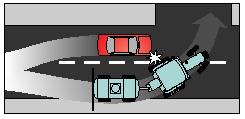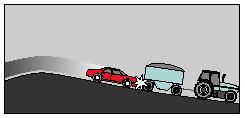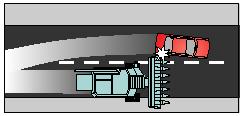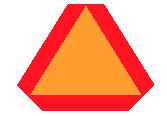Pm-1629 | August 1995
 If
you've driven on many of Iowa's rural roads, you know how
your spine tingles when you pop over a hill and come upon
a slow-moving tractor. Only a split-second reaction can save
you from a collision.
If
you've driven on many of Iowa's rural roads, you know how
your spine tingles when you pop over a hill and come upon
a slow-moving tractor. Only a split-second reaction can save
you from a collision.
Each year, Iowa farmers move nearly two billion bushels of grain and millions of livestock from production to market, much of it on the county and state highway system. Because all Iowans share the same roads, it helps to know what to look for. This brochure reviews three common ways that farm vehicles are involved in traffic accidents. Defensive driving tips are given for each situation.
At least
half of all deaths from unintentional injuries are caused
by motor vehicles. According to the National Safety Council,
this represented 42,000 deaths in 1993; two out of three
deaths were in rural locations. A study of Iowa traffic reports
between 1988 and 1992 showed 1,333 reports involved agricultural
vehicles, almost one collision every day on Iowa roads. Information
in this brochure is based on that study conducted at Iowa
State University.
 The scenario: The left-turn collision is the most common type of farm vehicle accident on public roads. It happens when the farm vehicle is about to make a left turn; meanwhile, the motorist behind the farm vehicle decides to pass. The study showed 297 such reports in five years (22 percent of all farm vehicle collisions).
The scenario: The left-turn collision is the most common type of farm vehicle accident on public roads. It happens when the farm vehicle is about to make a left turn; meanwhile, the motorist behind the farm vehicle decides to pass. The study showed 297 such reports in five years (22 percent of all farm vehicle collisions).
Why it happens: Like semi-truck drivers, operators of large farm vehicles, such as combines or tractor-wagon combinations, sometimes make wide left turns. Farm operators may swing to the right before making a left turn because they need the extra room to line up with a farm gate or driveway. This can be confusing, especially if you think the farm operator is moving over to let you pass.
Defensive driving tips:
-Is it really turning? Don't assume a farm vehicle that pulls to the right side of the road is going to turn right, or is letting you pass. Check the operator's hand signals.
- Is there a turn signal? A flashing light on a tractor that suddenly stops flashing is a turn signal. Slow down when you see this signal.
-Where
could it turn? Check the left side of the road for gates,
driveways, or any place a farm vehicle might turn.
 The
scenario: The rear-end collision is the second most common
type of farm vehicle accident on public roads. The study showed
247 such reports in five years (20 percent of all farm vehicle
collisions).
The
scenario: The rear-end collision is the second most common
type of farm vehicle accident on public roads. The study showed
247 such reports in five years (20 percent of all farm vehicle
collisions).
Why it happens: It's easy to misjudge speed when you come upon a slow-moving vehicle. In most cases, you have only a few seconds to react and slow down. For example, if you're driving 55 miles an hour and come upon a tractor that's moving 15 miles an hour, it only takes five seconds to close a gap the length of a football field between you and the tractor.
Defensive driving tips:
-Be alert. Always watch for farm vehicles on rural roads, especially at planting and harvest.
-Slow down immediately. As soon as you see a slow-moving vehicle, start to apply brakes like you would when approaching a stoplight.
-Keep
your distance. Stay a safe distance behind farm vehicles.
Most farm equipment is not designed to travel at speeds greater
than 25 miles an hour. Even when towed behind a truck, equipment
such as sprayers and fuel tanks often travels less than 25
miles an hour.
Passing
collision
 The
scenario: Many collisions also occur when motorists pass
farm vehicles. The study showed 51 such reports in five years
(4 percent of all farm vehicle collisions).
The
scenario: Many collisions also occur when motorists pass
farm vehicles. The study showed 51 such reports in five years
(4 percent of all farm vehicle collisions).
Why it happens: Some farm operators haul equipment that is extra wide or long, which motorists don't consider when they plan to pass. Many people assume that collisions happen during bad weather or hazardous conditions. The study showed nearly 80 percent of the collisions happened on dry roads.
Defensive driving tips:
-Be patient. Don't assume the farmer can move aside to let you pass. Shoulders may be soft, wet, or steep, which can cause the farm vehicle to tip, or they may not be able to support a heavy farm vehicle.
-Make sure you're clear. When passing, make sure you can see the farm vehicle in your rear-view mirror before you get back in your lane.
-Enjoy
the drive. Even if you have to slow down to 20 miles an
hour and follow a tractor for two miles, it takes only six
minutes of your time, about the same as waiting for two stoplights.
Sharing
Iowa Roads with Farm Vehicles
 Iowa roads can be used safely by everyone. To help you enjoy
your time on Iowa roads or make your work commute safer, remember
these tips.
Iowa roads can be used safely by everyone. To help you enjoy
your time on Iowa roads or make your work commute safer, remember
these tips.
-Many collisions with farm vehicles happen during fall harvest. October has nearly twice as many collisions as any other month.
-The most common time of day for collisions to occur is between 4 and 8 p.m. This may be due to the large number of commuters coming home from work, plus farm operators returning from fields.
-Recognize this sign. It means slow down because the vehicle is traveling less than 25 miles an hour. SMV emblems are florescent orange outlined in red. You should be able to see them at least 500 feet away.
-Stay back at least 50 feet when following farm equipment.
Publication #: Pm-1629
Safe Farm is an ISU Extension project helping to make Iowa farms a safer place to work and live. This publication is funded with federal 402 funds administered by the Governor's Traffic Safety Bureau and the Iowa Department of Public Safety. The Iowa Cooperative Extension Service's programs and policies are consistent with pertinent federal and state laws and regulations on nondiscrimination regarding race, color, national origin, religion, sex, age, and disability. Issued in furtherance of Cooperative Extension work, Acts of May 8 and June 30, 1914, in cooperation with the U.S. Department of Agriculture. Nolan Hartwig, interim director. Iowa State University of Science and Technology, Ames, Iowa. Promoting Agricultural Health & Safety Prepared by Charles Schwab, extension safety specialist, and Laura Miller, extension communications. File: Safety 2-2 and 2-4
Disclaimer and Reproduction Information: Information in NASD does not represent NIOSH policy. Information included in NASD appears by permission of the author and/or copyright holder. More